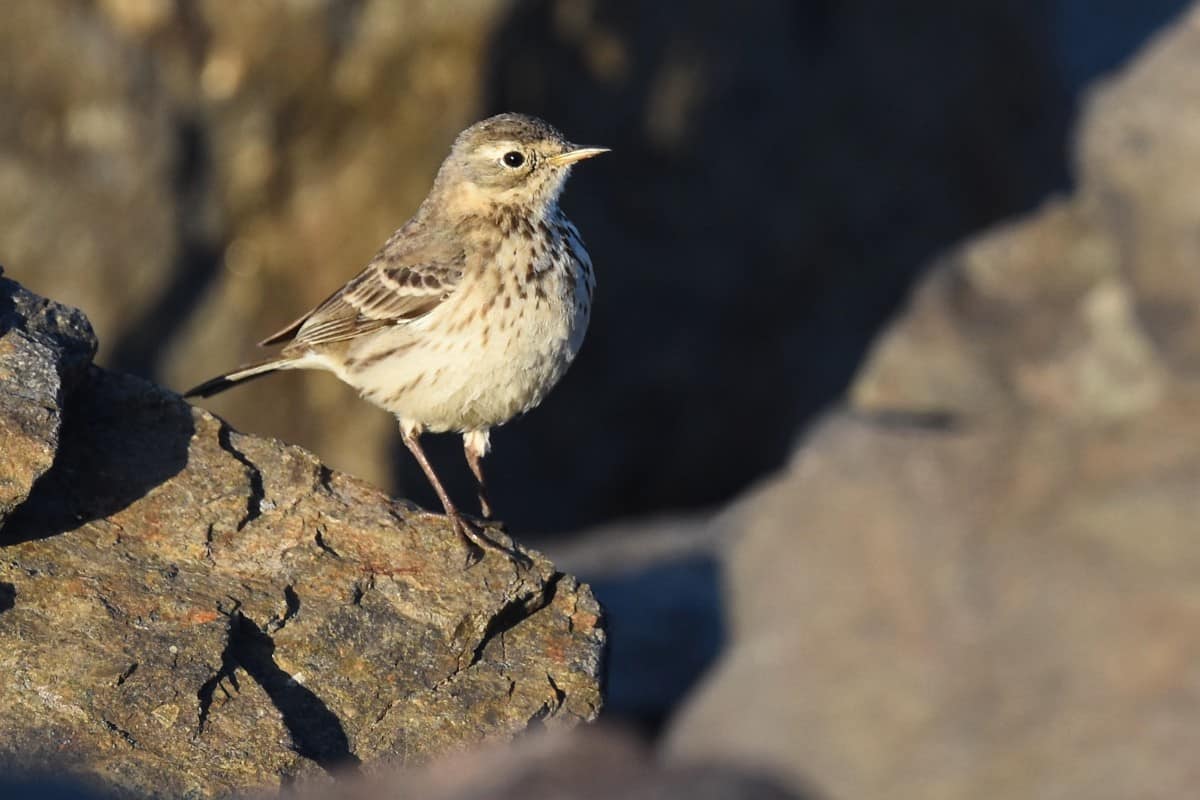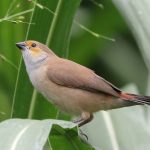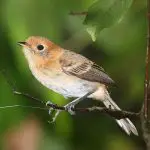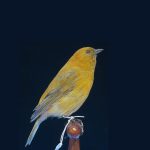American pipit standing on a rock | image by Wildreturn via Wikimedia Commons | CC BY 2.0
Common Name: American Pipit
Scientific Name: (Anthus rubescens)| Size | Diet | Range in Hawaii | Status in Hawaii |
|---|---|---|---|
| 5.5 in. - 6.7 in. | spiders, beetles, ants, and grasshoppers | Unknown | Least Concern |
The American Pipit (Anthus rubescens), also known as the Buff-bellied Pipit, is a fascinating and unique bird species that is native to North America. With its distinctive brown and white plumage and melodious singing, this bird is a beloved sight in its natural habitat. However, the species is also known to make appearances as a non-breeding visitor and vagrant in Hawaii, where it is a rare and exciting sighting for birdwatchers.
In this article, we’ll explore the fascinating world of the American Pipit, its unique adaptations, and behavior in the wild.
American Pipit
Appearance
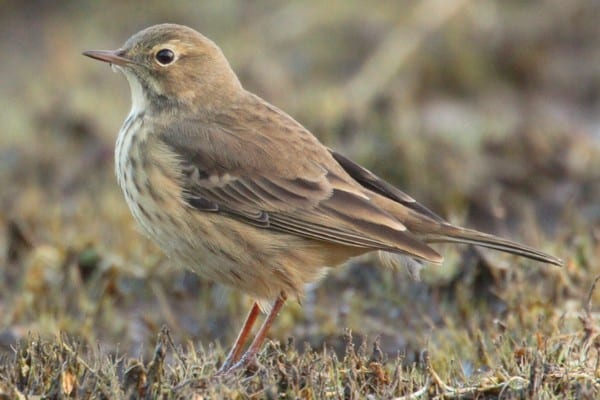
The American Pipit is a captivating songbird known for its understated beauty. Measuring approximately 5.5 to 6.7 inches (14 to 17 centimeters) in length, this small passerine showcases a slender build and a long, thin, and slightly curved bill perfectly suited for its insectivorous diet.
The plumage of the American Pipit varies depending on the season, with a more vibrant appearance during the breeding season. In summer, it sports a brownish-gray back, streaked with dark markings, while its underparts transform into a pale white or buff color with subtle streaks. During winter, its plumage becomes lighter and more muted, blending well with its surroundings.
Diet
This small songbird primarily feeds on insects and their larvae, making it an adept aerial forager. It skillfully hones in on flying insects, capturing them on the wing with its agile flight and nimble maneuvers.
The American Pipit also scours the ground in search of invertebrates like spiders, beetles, ants, and grasshoppers. In addition to its insect-rich diet, this adaptable bird is known to supplement its meals with seeds and small fruits during the non-breeding season when insects may be scarce.
Nesting
The American Pipit, also known as the grassland lark, chooses remote and often harsh environments as its nesting grounds. From the rocky slopes of mountains to the expansive Arctic tundra, this resourceful bird adapts to various habitats with ease.
Meticulously crafted, the pipit’s nest is an engineering marvel, blending seamlessly with its surroundings. Utilizing a combination of grasses, mosses, and delicate plant stems, the bird weaves a cup-shaped structure that provides excellent insulation and camouflage. Its shallow design allows for optimal heat retention, crucial for the survival of vulnerable chicks in the chilly climates they call home.
But what truly sets the American Pipit’s nesting behavior apart is its choice of location. Rather than building nests on the ground like many other songbirds, it takes advantage of elevated perches.
Boulders, rock ledges, or even stunted shrubs serve as ideal platforms for these skillful architects. This strategic decision not only protects their offspring from potential predators but also grants them a panoramic view of their surroundings, ensuring the safety of their future broods.
Within these hidden nests, a small clutch of pale eggs, delicately speckled with brown, awaits the nurturing care of their parents. Both the male and female share the responsibilities of incubation, carefully tending to their future progeny and rotating duties with remarkable precision.
As the fledglings emerge into the world, their parents guide them through the wilderness, teaching them the art of foraging and survival. The American Pipit’s nesting habits not only demonstrate their adaptability but also their dedication to providing a secure foundation for the next generation.
Behavior
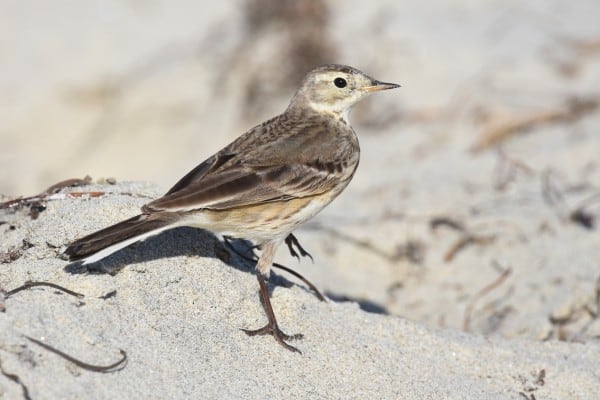
A skilled acrobat in flight, the American Pipit can be spotted soaring through the skies with agility and elegance. With its wings slightly pointed and fluttering, it moves in a distinctive undulating pattern, punctuating the open spaces it inhabits with its graceful presence. This aerial display not only serves as a means of transportation but also enables the pipit to survey its surroundings for potential food sources or threats.
On the ground, the American Pipit unveils another impressive skill: its foraging prowess. Equipped with a slender beak, perfectly suited for its insectivorous diet, the pipit employs a unique technique known as “foot-treading.”
It delicately steps on patches of grass or foliage, creating a subtle vibration that dislodges hidden insects and arthropods, making for an easy meal. This method showcases the bird’s resourcefulness and ability to exploit even the most inconspicuous food sources.
During the breeding season, the male pipit engages in a mesmerizing courtship ritual. Displaying its striking plumage, the male ascends into the sky, performing a series of aerial displays and melodious songs, all aimed at capturing the attention of potential mates. This captivating exhibition not only demonstrates the male’s fitness and genetic superiority but also adds a touch of enchantment to the bird’s behavior.
Despite its small size, the American Pipit’s migratory instincts are awe-inspiring. Each year, these resilient birds embark on long-distance journeys, navigating thousands of kilometers across the continent.
With an innate sense of direction, they traverse vast landscapes, from the Arctic regions to the southern reaches of North America, in search of favorable breeding and wintering grounds. This remarkable feat of endurance showcases the pipit’s tenacity and its ability to adapt to ever-changing environments.
Habitat
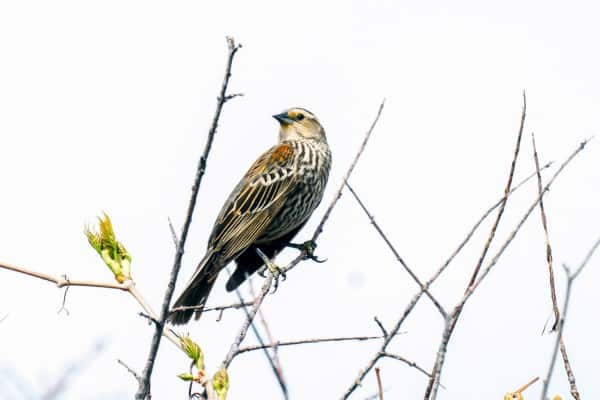
The American Pipit, Anthus rubescens, is a bird species that thrives in a variety of habitats across North America. From open grasslands and meadows to alpine tundra and coastal areas, the American Pipit displays remarkable adaptability. It can be found in both terrestrial and semi-aquatic environments, making it a versatile and resilient species.
Range
The American Pipit is a non-breeding visitor and vagrant in Hawaii. This Nearctic species primarily breeds in Alaska, Canada, and at higher elevations of larger mountain ranges to the south. Only one record exists for the species in the Hawaiian Islands, a single first-cycle female of the subspecies japonicus, collected on Kure Island in the Northwestern Hawaiian Islands on Kure in 1963.
Conservation Status
The American Pipit, scientifically known as Anthus rubescens, is a remarkable bird species facing conservation challenges in its natural habitat. Currently classified as a species of “Least Concern” on the IUCN Red List, the American Pipit’s population remains relatively stable.
Interesting Facts
1. Species split
American Pipits were previously considered the same species as the Rock Pipit of Europe, known as the “Water Pipit.” However, they were later recognized as distinct species by the American Ornithological Union (AOU).
2. Camouflaged eggs
The eggs of American Pipits are beautifully camouflaged to blend with their surroundings. They have a pale coloration with speckles of brown, providing excellent protection from potential predators.
3. Recognizable flight pattern
When in flight, American Pipits exhibit a distinctive pattern of shallow wingbeats followed by short glides. This flight style sets them apart from other similar-looking bird species.
4. Caching behavior
American Pipits are known to engage in caching behavior, where they store surplus food items for later consumption. They may hide or bury insects in the ground, returning to retrieve them when needed.
5. Studied by bird banding
American Pipits are among the bird species that have been extensively studied using bird banding techniques. Banding programs provide valuable insights into their migration patterns, longevity, and population dynamics.
Frequently Asked Questions
1. How long do American Pipits live?
In the wild, American Pipits can live for up to 10 years. Their lifespan is influenced by factors such as habitat quality, food availability, and successful breeding outcomes.
2. Can I attract American Pipits to my backyard?
While American Pipits are not typically backyard birds, you may attract them if you have a large open space with grassy areas nearby, especially during migration when they are more likely to pass through.
3. Can I keep an American Pipit as a pet?
It is not recommended to keep wild birds, including American Pipits, as pets. They are best enjoyed in their natural habitats, and it is important to respect their wild nature and conservation status.
4. Are American Pipits considered a valuable indicator species?
Yes, American Pipits are considered an important indicator species for assessing the health of grassland ecosystems. Their presence and population trends can provide insights into the overall condition of these habitats and the impacts of environmental changes.
5. Can American Pipits imitate other bird songs?
American Pipits do not have a reputation for mimicking other bird songs. They primarily produce their distinct high-pitched calls and warbling songs.
